Features of flushing the heating system: review of the best methods
Gradual corrosion of metal on the inner surface of pipes and radiators in the heating circuit, crystallization of salts in the coolant, lead to clogging of the heating system and a decrease in its overall efficiency.
Regular flushing of the heating system to remove foreign particles from the heating circuit will help prevent this.
The content of the article:
Signs of a poorly maintained heating system
For normal functionality heating systems nothing should interfere with the movement of the coolant through the channels constructed for it.
There are several symptoms that a large amount of debris has accumulated inside the heating circuit, and scale has settled on the walls of the pipes. There are no obvious visual signs of clogging of the heating system.
It can be diagnosed by carefully monitoring the operation of the entire system and the appearance of a number of indirect signs:
- warming up of the system takes longer than before (for autonomous heating systems);
- the operation of the boiler is accompanied by uncharacteristic sounds;
- increased gas or electricity consumption;
the temperature in different parts of the radiators varies significantly; - radiators are noticeably cooler than supply pipes.
However, weak or uneven heating of batteries is not always a sign of clogging. Perhaps it happened airing. In such a situation, it is enough to reset the air lock through tap Mayevsky.
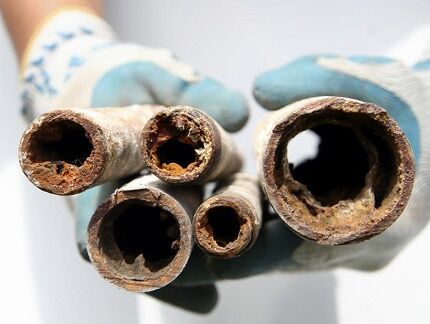
In houses with a central heating system, its flushing should be carried out by employees of the heat supply company.In a private home, this procedure is carried out by the owners or invited specialists.
It is difficult to unequivocally recommend the frequency of flushing the system. There are too many factors influencing this.
For example, in centralized heating systems, the coolant must undergo a water treatment cycle, which reduces the degree of contamination. True, this rule is not always followed. And the system itself is often in its third or fourth decade of operation, and the amount of waste circulating inside increases every year.
But both for centralized networks and for autonomous systems, it is recommended to carry out flushing annually. Which, by the way, is confirmed by the requirements of building codes. This period is considered critical for the accumulation of debris inside the circuit, which significantly reduces operating efficiency.

Options for flushing heating systems
Depending on the degree of clogging of the heating system, the volume and length of the circuits, several options for flushing heating systems can be implemented:
- mechanical;
- hydrochemical;
- hydrodynamic;
- hydropneumatic;
- electrohydropulse.
The first two methods do not require sophisticated equipment and can be carried out without problems on your own. The remaining methods require an appropriate level of technical equipment of the performers. Therefore, to implement them, you will either have to rent equipment or invite specialists to perform such work.
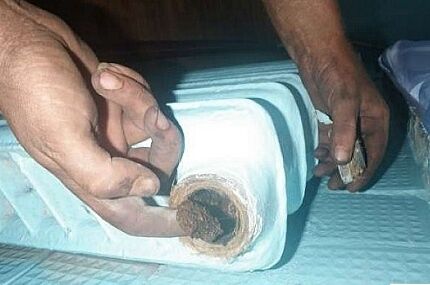
But in any case, there are certain rules for flushing autonomous or centralized heating systems, failure to comply with which will make the procedure ineffective. Next, we’ll talk in detail about each of the cleaning options so that the effect of the procedure is maximum.
Method #1 - mechanical flushing
It is immediately worth noting that such flushing is aimed, first of all, at cleaning the radiators from accumulated dirt, and to a lesser extent from scale on the inner surface of the circuit. Shut-off valves, expansion tank and circulation pump, if it is built into the system, you will have to clean it separately.
Before starting flushing, make sure that the used coolant in the system, during the cleaning process, a minimal amount went out. The procedure must begin by closing the valves that limit the flow of coolant into the circuit.
If the procedure is carried out in a high-rise building, then the valves are usually located in the basement of the house. In a private house, the valves before and after the boiler are closed.
The next stage is draining the coolant from the circuit. This can be done either through the drain valve, which was originally installed when installing the system. If there is no such tap, then draining is done by unscrewing the plug on the radiator located below or further than all the others.
It is most convenient to discharge the coolant through a hose connected to the drain tap and discharged into the toilet or other plumbing fixture connected to the sewer. Mechanical cleaning will be more effective if you first remove the batteries and clean them separately. heating devices and pipes.
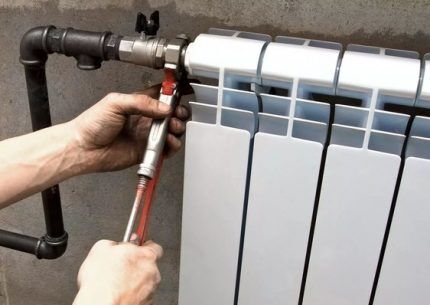
The procedure for dismantling radiators made of different materials is essentially the same. But in any case, you should prepare a container to drain the remaining coolant.To carry out the procedure itself, you will need keys of the appropriate size. To unify the process, it will be useful to have a pipe wrench – a “butt” – in your arsenal.
Depending on what Radiators are connected to the diagram, the dismantling procedure is also different. In any case, the radiator has an inlet and outlet for coolant. During dismantling we release cap nuts connecting radiators to pipes. During the first one or two turns of the nut, you need to be prepared for the fact that the remaining water will begin to ooze out of the connection. We collect it with a rag.
After the leakage of the untwisted joint "radiator pipe» increases, we collect the flowing coolant into a container - a basin, a trough or something similar. At the same time, we carefully ensure that the coolant does not leak to the lower floor.
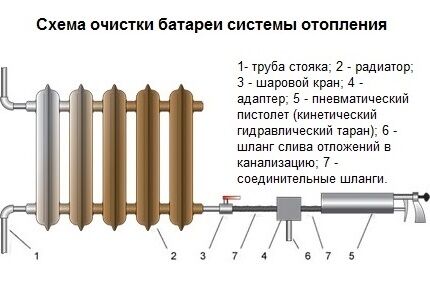
After dismantling the radiator, we take it either into the yard or into the bathroom. At the same time, we cover the plumbing fixtures from damage to the enamel coating with thick fabric, which you don’t mind throwing away later. Sink drain or bathtubs must be covered with a mesh to prevent clogging of the siphon and sewer.
Mechanical cleaning of the radiator can be done with a cable similar to the one used to clean the sewer. We carry out the same procedure with pipelines. However, for a network with a large number of turns, mechanical flushing will be difficult.
After cleaning the batteries and pipelines is completed, we proceed to rinsing them with water.We wash the radiators there in the bathtub or in the yard, directing a stream of water from a hose inside.
To flush pipes, it is more convenient to use hoses with adapters. They allow you to hermetically dock the hoses for supplying water to the heating circuit and for draining it into the sewer. The heating system is flushed with water until it comes out clean.
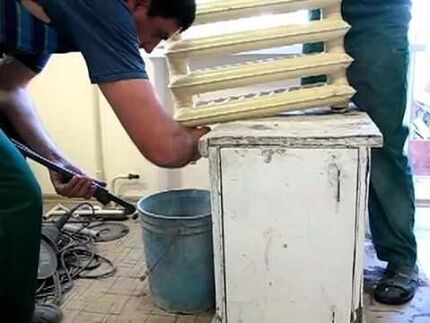
After washing the radiators and pipes, you can repeat the mechanical cleaning procedure. To make the procedure more effective, it is better to insert the cable in the direction opposite to the direction of movement of the coolant.
This is done so that the “scales” that have settled in the direction of movement are torn off as a result of mechanical contact. If there is less dirt in the flowing water than during the first round of cleaning, then the procedure is effective.
Method #2 - hydrodynamic cleaning
When choosing this method of cleaning systems, the procedure will require special equipment. In this case, water is supplied not from a tap using a regular hose, but from a pump under high pressure.
Sometimes, during hydrodynamic flushing, the pump is connected to a break in the heating circuit as far as possible from the point of discharge of dirty water. But more often for these purposes a special hose with end switch.
The design of the end nozzle has small diameter holes. Through them, water flows out under high pressure.
It is the accentuated effect of water jets supplied under pressure that makes it possible to effectively combat mud and salt deposits. The supply hose can be specially stopped in potentially problematic areas for more efficient rinsing.
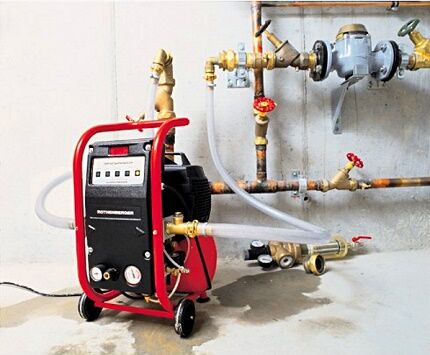
When selecting a hose for hydrodynamic flushing, you must take into account that if it is sufficiently rigid, you can apply pressure further from the inlet. True, at turns in heating system pipes, it is problematic to push such a hose further.
Therefore, when carrying out hydrodynamic flushing using a hose, you will have to sequentially open the heating circuit in several places to supply water to all points.
Method #3 - chemical flushing of the system
It is possible to perform flushing without mechanical intervention. For these purposes, there are either ready-made chemical compounds or solutions that are easy to prepare at home. Dismantling of heating radiators is not required.
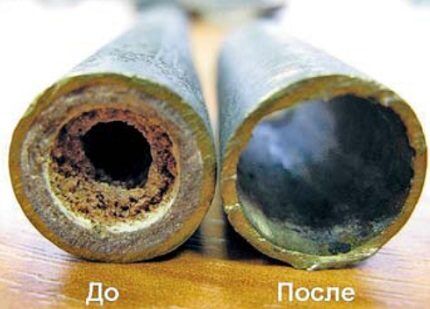
The disadvantage of chemical flushing is the prohibition of using aluminum radiators for flushing and a large number of caustic solutions that require disposal in specially designated areas.
If the heating circuit is not very clogged, then for its preventive flushing it is quite possible to use:
- caustic soda;
- vinegar;
- available acids (phosphoric, orthophosphoric and others);
- whey and others.
But it is better to use specially developed formulations for these purposes. Their packaging will not only indicate the recommended use case (pipe material, nature of contamination, etc.), but also detailed instructions for use.
Focusing on the instructions will allow you not only to use the composition as efficiently as possible, but also to clean the heating system at the lowest cost.
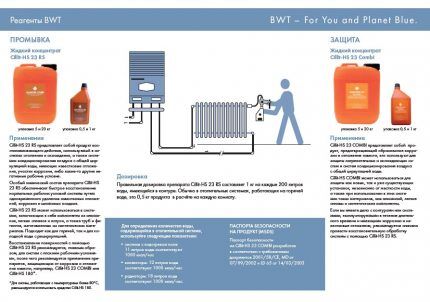
It is recommended to maintain the time intervals of action of the reagents as accurately as possible. At the same time, in autonomous systems, do not forget to turn on the circulation pump to ensure even distribution of the “activated” coolant.
To carry out this type of flushing, it is useful to have at your disposal a pump with a container - a booster. In order to connect it to the system, you need to create a break in the circuit. This can be done, for example, by disconnecting the direct flow from the boiler to the heating circuit. The circuit must also have a valve for discharging the used reagent.
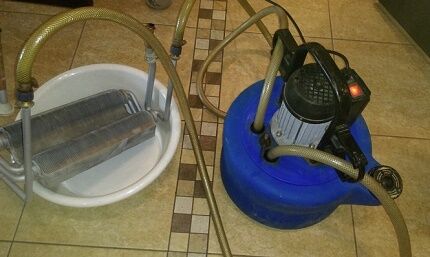
To ensure uniform destruction of scale on pipes and radiators, after pumping in the reagent, leave it in the system for a period of several hours to several days. The main disadvantage of this cleaning method is the possible negative impact of the active substance on the surface of the pipes. Therefore, after treating the system, rinse it with clean water.
A more gentle, but similar in action, method of cleaning heating system pipes from overgrowing is dispersed cleaning.
In this case, a reagent is introduced into the system, acting exclusively on settled particles. In this case, the metal remains without negative effects. And the procedure itself is similar to chemical cleaning.
Method #4 - hydropneumatic cleaning
One of the most effective and equipment-friendly cleaning options heating systems flushing the heating system is considered to remove accumulated dirt hydropneumatic method. Its essence is to supply air under high pressure inside the heating circuit.
Air is supplied to the circuit by a compressor. In this case, turbulent flows with high kinetic energy are created inside the pipelines. Due to this, growths are removed from the inner surface and accumulated dirt is washed out of the radiators.
Turbulent flows do not pass through the heating circuit constantly, but from time to time in the form of short-term pulses. Create such impulses with the help air gun. The compressor is connected to the circuit through a check valve. This will prevent water from entering the compressor.
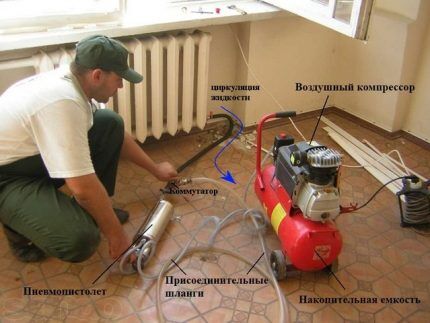
To carry out flushing, we shut off the flow of coolant into the circuit. Then we connect the compressor with with a pneumatic gun. If flushing is carried out without dismantling the radiators, then unscrew the plug on the farthest radiator and connect a hose through the adapter to discharge debris and discharge it into the toilet.
The first air supply to the system should be done in the opposite direction to the direction of coolant circulation. The procedure can be repeated by changing the direction (switching the hoses for supplying pressure and dumping debris).
Can hydropneumatic flushing is carried out by dismantling the radiators. It will be more troublesome, but also more effective. Then it is better to take the batteries outside and wash them there.
After finishing the washing procedure put the radiators in place, connect the circuit to the boiler and let it flow into the coolant pipeline. Those remaining debris that are in the system will be washed out with water.
Then we briefly shut off the flow of coolant, undock drain hose and return the plug to its place. Now you can put the system into operation.
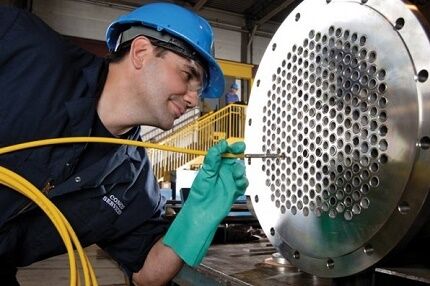
Method #5 - electrohydropulse methodology
The operation of this flushing method is based on the use of electrical pulse energy, which is aimed at destroying salts deposited on the walls of pipelines. It is effective precisely for combating such blockages in heating systems. The pipes themselves are not affected.
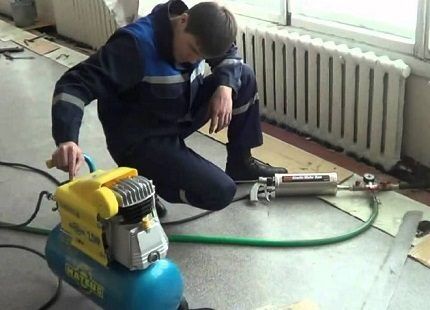
A special apparatus is used to generate an electrical impulse. A coaxial cable is connected to it, at the opposite end of which a discharge is formed, the shock wave from which destroys the scale on the inner surface.
After this, the system is washed with clean water to remove foreign particles separated from the surfaces.
Cleaning the system using the electric pulse cleaning method requires special equipment. But its efficiency is quite high and there is no need to disassemble the system for flushing. Moreover, unlike chemical cleaning, all slag can be poured into the sewer without hesitation.
Conclusions and useful video on the topic
Video #1. Efficiency of application hydropneumatic Radiator flushing can be assessed by the amount of dirt thrown out:
Video #2. The subtleties of performing a chemical type of flushing of the heating system are outlined in the following story provided by the owner of a private household:
Any of the considered options for flushing heating systems does not represent an overly complicated procedure. If you have some experience in plumbing work and, in some cases, special equipment that can be rented, you can perform this operation yourself.
Do you want to ask a question about the effectiveness of flushing or tell us how you flushed the heating circuit in your home? Do you have valuable recommendations or important nuances that you would like to share with site visitors? Please write comments in the block form below.





The batteries have not been cleaned for more than 5 years and somehow no thought was given to it. Apparently, the employees of the heating supply organization are not aware of such events. You'll have to clean it yourself. I didn’t find a description of hydrochemical cleaning, there is simply a chemical one. Apparently this is a reagent + cable. And if there is no pump, then you can simply pour the reagent into the radiator for a while, then clean it with a cable, and finally rinse it under high water pressure? Or it won’t help, after all, 5 years, and maybe more (only we have been living in an apartment for 5 years!). And no one cleaned anything.
The chemical is diluted with water and poured into the system. Then the water is heated to the maximum degree and at this moment is drained from the heating circuit. Next, the entire system is washed, clean water is poured into the system and pressure testing is performed.
If you still have metal pipes installed, I advise you to replace them with plastic ones. Plaque will not build up in them as quickly as it does in metal pipes. After changes in legislation, utility companies are no longer responsible for maintaining radiators in apartment buildings in proper condition.
From personal experience, I can recommend a chemical method for cleaning heating systems and radiators. Just hire a specialist to do this, rather than doing it yourself.A qualified worker will do everything necessary in one day, while modern solutions make it possible to carry out this procedure without any negative consequences.
If you replace the pipes with plastic, then you can clean the radiators of scale and deposits yourself.
I work for a company that sells solutions and concentrates that are safe for household use and easy to use for flushing heating systems and removing rust, scale and deposits. After consuming the products we offer, repeated rinsing with additional chemicals is not required. reagents that are designed specifically for various materials.
Please provide contacts or a link to the company.
Is the chemical method suitable for a private home or is it only for city apartments? Recently, problems have begun with circulation in the system - the top of the battery is hot, the bottom is slightly warm.
Hello. Yes, of course it does. It’s best to entrust this to specialists.
Please note that such symptoms may also indicate air entering the system, problems with shut-off valves, a decrease in pressure in the line, poor coolant circulation, or cold in the room in which the problematic radiators are located.
Chemical flushing is done when there is a need for strong deposits or, as often happens, the client has problems with the system; he drains the coolant and switches to water; he attached a photo of such a system, but forgetting that the coolant has a shelf life of 5 years; without flushing the system, the remaining coolant begins to decompose, clogging everything that is possible and eating metal and this phenomenon is often typical in places where joints are not sealed, leaks appear in the form of black leaks or in the form of rust. That's when chemical washing is done. And in most cases, hydrodynamic flushing of water and air and pulsation pressure are enough to knock out all the debris from the system. You can buy reagents for flushing the system here http://www.heateplo.ru
This is just an idea for now. Perhaps someone has already thought about it. I suggest installing a filter with a lid in the place where the return line enters the boiler. KOLGON is poured through this lid. And the transparent walls of the filter flask allow you to visually observe the cleaning process. And, in general, see the state of the coolant (water).